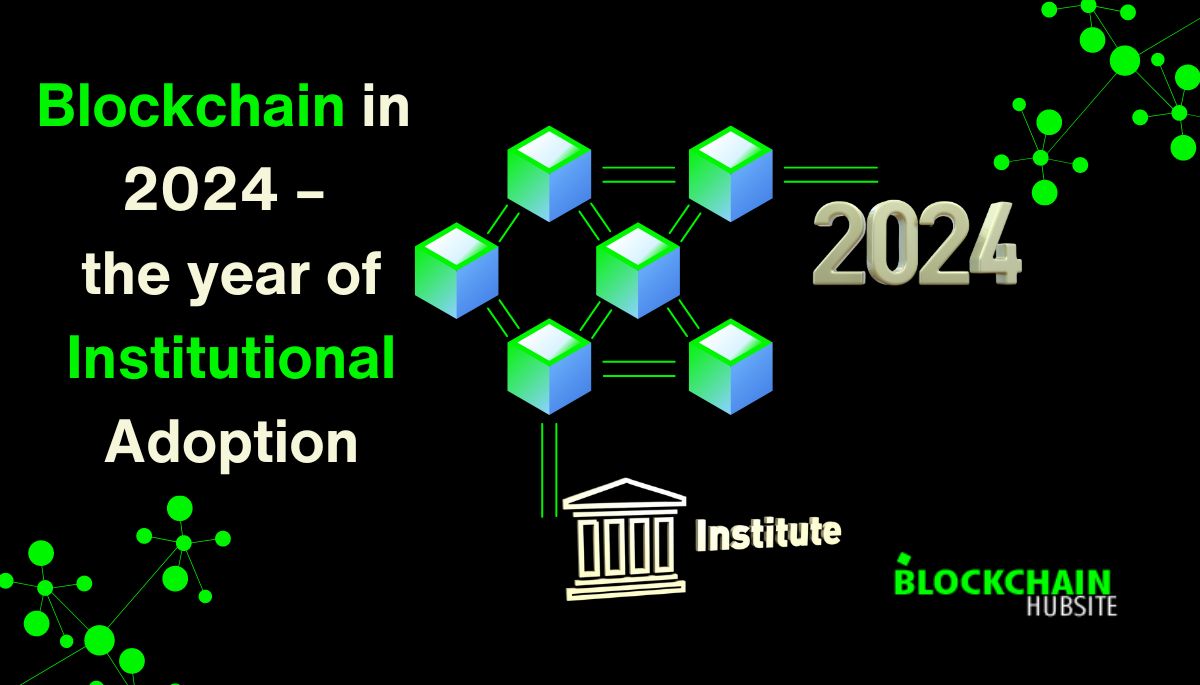
Table of Contents
Introduction
Blockchain technology is expected to become widely used in the industry in 2024 after more than a decade of speculation, trials, and pilot programs. Institutional and corporate adoption of blockchain-based solutions is accelerating as all the necessary components are coming together.
A mature blockchain technology that lowers risks, more precise rules that boost trust, the appearance of compelling new business use cases, and growing institutional investments that support the market are some of the main things that have led to this turning point. Let’s put it this way: blockchain is evolving from a frontier innovation to a reliable, mature platform ready for widespread use.
We are already seeing the beginnings of this adoption surge in 2024. International Data Corporation (IDC) predicts that global spending on digital transformation (DX) will reach $3.9 trillion in 2027, growing at a CAGR (compound annual growth rate) of 16.1% over the next five years, in order to accomplish this goal.
Major corporations, including Walmart, Oracle, JPMorgan, and Amazon Web Services, are increasing their blockchain operations. A lot of central banks around the world are also testing national digital currencies that are built on blockchain.
Embracing the revolutionary wave of Blockchain in 2024 – the year of institutional adoption, where the convergence of technology and money reshapes the landscape of trust and transparency.
The article explains why institutions are getting involved this year, how enterprise blockchain development is changing, and what problems still need to be solved before it can be widely used. After years of empty promises, blockchain will hit a tipping point in 2024 and start making a real impact across industries. We are rapidly reaching the much-anticipated blockchain revolution in the corporate world.
Central Bank Digital Currencies: The Momentum Builds

The international adoption of central bank digital currencies (CBDCs) is showing no signs of slowing down as we enter the year 2024. Recent reports from the Digital Currency Governance Consortium indicate that more than 100 countries are investigating the possibility of a CBDC, with major economic powers such as the United States, China, and the European Union speeding up the process. Just last year, the eNaira CBDC in Nigeria was fully launched, and DCash was made live by the Eastern Caribbean Central Bank. Critical study papers analyzing optimal design possibilities were also released in 2023 by the IMF, World Bank, and BIS.
Why is CBDC gaining momentum? While encouraging more people to use their money, central banks are trying to stop decentralized cryptocurrencies from undermining their authority over the money supply. The COVID-19 outbreak further highlighted the necessity of digital payment methods. In light of these reasons, industry watchers anticipate 24 CBDC launches by the year 2027. The majority will likely approach the move strategically in stages, focusing on wholesale and retail.
The regulatory groundwork can be laid, and technological knowledge can be accumulated through gradual, tiered adoption. Commercial banks need to get ready to participate and take part in CBDC pilot programmes as the number of monetary authorities doing so grows. Integration of services for identification verification, wallet provisioning, and exchange connectivity is crucial for facilitating widespread adoption.
Despite concerns about potential disintermediation, CBDCs present banks with fresh income streams related to smart contracts and currency management. To make sure CBDCs improve the financial ecosystem, central banks and commercial banks must work together, not against one another.
Programmable Payments Usher in The Era of Smart Money

By allowing programmability inherent in the currency, digital currencies issued by central banks have the potential to revolutionize payments. This indicates that money will transition from being a fixed store of value to becoming a dynamic smart contract that can react to actions and circumstances that occur in real-time.
But businesses may start reaping the benefits of programmable money immediately, without having to wait for an official CBDC. The addition of conditional payment capability to JPMorgan’s stablecoin JPM Coin on the Onyx blockchain is a first of its kind worldwide.
With the use of smart contract logic, JPM Coin payments can now follow predetermined protocols for execution. Factors like margin restrictions, account balance thresholds, and delivery verification can cause these personalized payments to be automatically modified. In order to streamline company processes, Siemens is already using JPM Coin transactions that can be programmed.
When money is interwoven with intelligence, the possibilities are endless. By implementing real-time reconciliation, banks can shorten settlement times, facilitate dynamic treasury management, and aid in the simplification of accounting. New potential for monetization, streamlined global trade, and automated financing are all ways their corporate clients gain.
Experts in the field expect widespread adoption in 2024 thanks to this first foray into programmable payments by a big US bank. This proves that blockchain technology advancements can happen independently of CBDCs. More ambitious CBDC capabilities can be enabled in the future through private sector experiments with smart currency. In order to better serve their customers now and in the future, banks should look into programmable money.
Blockchain Regulation Ramps Up in Maturing Ecosystem

It is abundantly evident that the digital asset business needs appropriate regulation and control in light of the failure of big crypto companies like FTX and scandals around money laundering. Some governments, like the United Kingdom and the European Union, announced their intentions to pass cryptocurrency laws in 2023. Nonetheless, this front is expected to witness a global acceleration in 2024.
Reports indicate that the Financial Stability Board, the International Monetary Fund, and the World Bank will release policy recommendations. These guidelines recommend minimizing the risk of illegal funding, increasing exchange openness, and safeguarding investors. Notable nations will also advance crypto-asset legislation, such as India’s Cryptocurrency and Regulation of Official Digital Currency Bill, introduced last year.
Additionally, decentralized technologies are soon to be subject to broader blockchain legislation. The commercialization of concepts like embedded finance, tokenization of assets, and the metaverse has made policymakers aware of the need for new frameworks to foster innovation without putting consumers at risk. Blockchain solutions for e-commerce, healthcare, and banking, among other industries, are now possible thanks to groundbreaking legislation.
For blockchain systems to reliably scale, there must be continual attempts to establish technology standards. Many organizations are updating their interoperability definitions and making them available to developers. These include the Enterprise Ethereum Alliance, ISO, IEEE, and W3C. Blockchain will mature responsibly if governments, businesses, and standards bodies work together.
Connecting The Blockchain Ecosystem Through Interoperability

“The development of blockchain interoperability protocols will bring transformation by 2024. These protocols will facilitate smooth communication, creativity, and building an increasingly effective blockchain ecosystem, particularly in the field of DeFi.”
– CTO of Ripple Labs David Schwartz
Making it possible for various networks and solutions to operate seamlessly is quickly becoming a top priority as blockchain use increases. There are still a lot of silos in the blockchain business, making it difficult for assets and data to move freely between chains. Users’ growing reliance on cross-protocol, cross-product, and cross-service interactions makes this a vital issue to fix.
To prevent ecosystem silos and guarantee holistic compatibility, constructing interchain operability will be crucial in 2024. Supporting frictionless cross-chain transfers and consistent standards requires convergence of both regulatory and technical initiatives. Technological advancements such as side-chains, protocols like Polkadot, and hash-time locked contracts (HTLCs) are releasing the door to transferability. Meanwhile, it is recommended that legislators support neutral frameworks that allow for interoperability between blockchain platforms and countries.
Security measures for infrastructure and cybersecurity necessary for interoperability are equally important. Networks need to put strong safeguards in place for things like privacy, node authentication, key management, and more because the risk of exploitation increases as the number of chains connected grows. Establishing trust and USEability requires balancing security concerns with the drive to interlink blockchains.
Blockchain’s Next Wave Will Priortize Trust and Sustainability
With the arrival of 2024, blockchain technology finally appears to be on the point of widespread acceptance. But this promise can only be realized with well-rounded governance that encourages innovation while simultaneously holding people accountable. Businesses and projects must now emphasize responsible disruption over security, compliance, and social responsibility. Connecting technology with its ethical effect is the way ahead.
Leaders in the industry are forming groups like the Crypto Climate Accord while lawmakers work on making complex rules that separate lawless decentralization from lawful decentralization. Through openness, access controls, and privacy protection, Web3 architects are also embracing digital trust principles. Trustworthiness is the latest game-changer.
The upcoming unicorns in the industry will fulfill the needs of stakeholders, including partners, customers, workers, and communities, in addition to shareholder value. Integrating blockchain technology to its full potential entails tying decentralization to the principles of integrity, excellence, and longevity. This is the recipe for widespread use: stifling innovation while simultaneously establishing order. Finding this middle ground will allow the second chapter of the technology to write itself.




